This time, we abused another affordable Nokia cell phone – the 6303i classic candybar with a stainless metal body.
The retail package of the Nokia 6303i is standard issue stuff (Pic. 1). The package box is flat and blue. The phone comes with the short USB data cable, the one-piece stereo headset and the charger (Pic. 2).
The well-rounded phone features an elegant design in stainless steel (Pic. 3, 4). However, the handset is not metal all over. The top part of the rear panel, housing the antenna, is plastic. The big screen has a QVGA resolution (320 x 240 px). At first glance, the Nokia 6303i classic boasts a camera with xenon flash. But actually the back features a dual LED flash right under the 3-megapixel camera lens. The phone weighs 96 grams and is powered by the Li-Ion 1050 mAh battery.
Results

Pic. 1. Package box

Pic. 2. Accessories
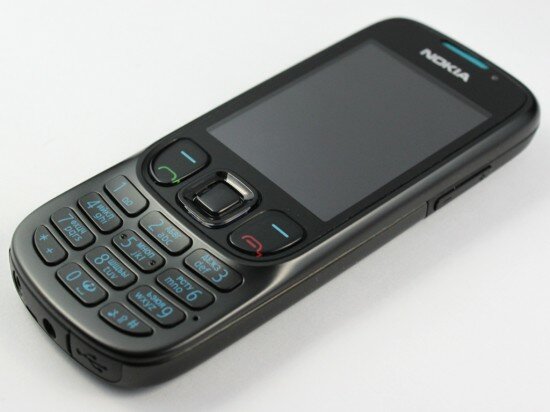
Pic. 3. Nokia 6303i classic (front panel)
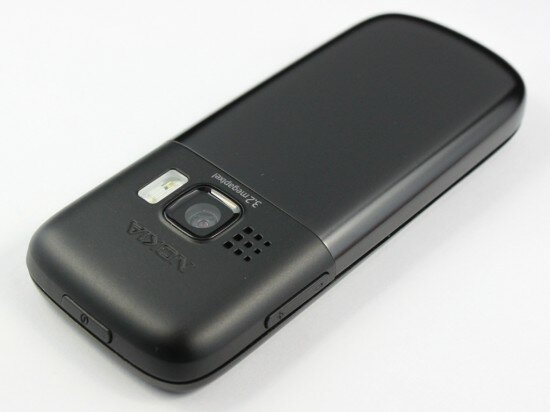
Pic. 4. Nokia 6303i classic (back panel)
1. Nokia 6303i classic stress test. Stage 1 — Light shocks
1.1 Drop test
No matter how carefully you use your cell phone, the bumps and knocks are inevitable. You may accidentally flap your handset off the table on the carpet or on the tiles, for example.
We found out how the Nokia 6303i classic stands up to the drops on the soft and on the solid floor. The phone was successively dropped on the carpet (video 1) with each face, edge, and corner from 1 m (3.28 ft) and on the tile (video 2) from 30 cm (11.8 inches). The 6303i was fixed in the machine that had been devised especially for this test in order to minimize the human factor.
The falls weren’t spectacular. The phone showed good results. The hits didn’t remove the battery cover, though it’s easy to remove it even by one hand. The Nokia 6303i classic sustained no damage and stayed functional.
Video 1. Drop on the carpet from 1 m (3.28 ft)
The grade is 30 (with 30 being the highest possible grade)
Video 2. Drop on the tile from 30 cm (11.8 inches)
The grade is 30 (with 30 being the highest possible grade)
1.2 Squeeze test
Mobile phone users may accidentally step on their handsets or sit down on them. In order to find out how the gadget fares after such situations, we placed it on a table and applied a 3 kg (6.6 lbs) pressure from a wooden bar above it (Pic. 5). It’s no wonder that the phone stayed fine. The Nokia 6303i is made of steel and has no protruding elements.
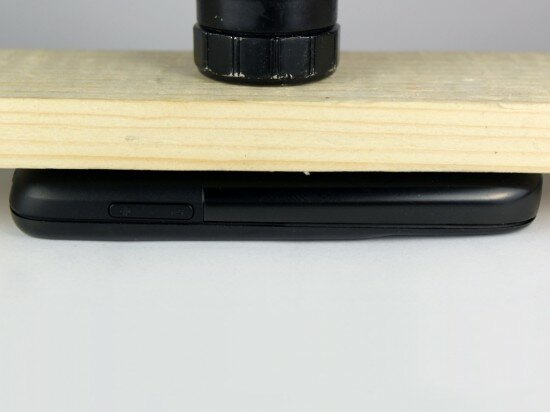
Pic. 5. The phone under the wooden bar
The grade is 24 (with 24 being the highest possible grade)
1.3 Bend test
Cell phone squeezing is a rare case. Bending is another threat and this occurs more often. For example, you may sit down with your phone in a back pants pocket.
In this test, we put the Nokia 6303i classic onto the two planks so that each edge of the phone lies on a single plank. Then we hitched a string with 1 kg load (2.2 lbs) on top of the device. The gadget showed no sign of bend and stayed functional.
The grade is 24 (with 24 being the highest possible grade)
1.4 Durability
In order to find out how the Nokia 6303i classic will look after a long period of everyday use and possibly abuse, we placed it inside a drum together with keys, pennies, and plastic balls to simulate what might be happening in a man’s pants pockets while carrying the phone (video 3). The drum was rotated at the speed of 500 rpm.
In 5 minutes we stopped the drum and took the Nokia out. We saw a lot of small scuffs on the paint of the steel casing (Pic. 6). The edges of the back panel looked lighter than the rest of the panel. In some parts of the phone, the paint was completely peeled off. We also saw the scuffs on the screen (Pic. 7). Despite the big scratches, the plastic part of the back panel stayed more attractive than the metallic battery cover.
Video 3. Drum rotation
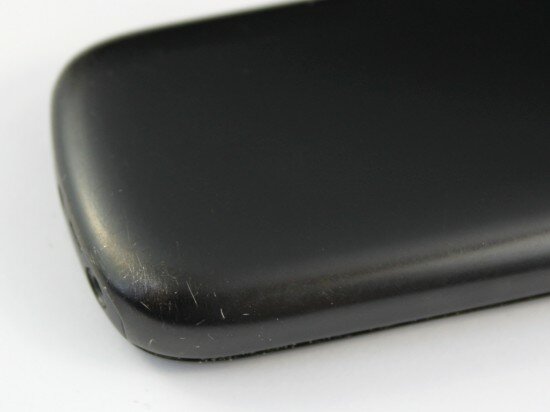
Pic. 6. Scuffs on the edges of the back panel
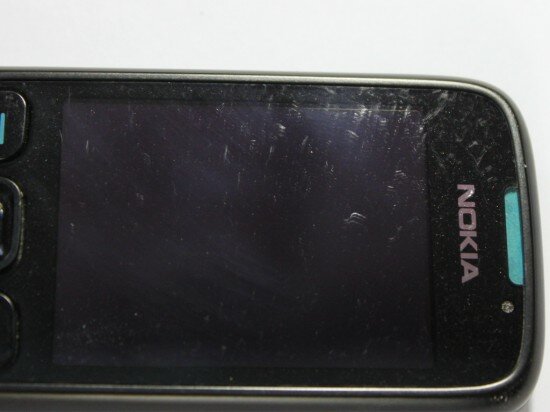
Pic. 7. Scuffs on the screen
The grade is 10 (with 15 being the highest possible grade)
1.5 Scratch test
In order to test scratch resistance of the Nokia 6303i classic, we scratched it with a nail fixed in a plank. The applied pressure from the nail was 100 g (0.22 lbs).
The screen sustained a minor scratch (video 4). But the steel back cover showed no damage at all.
Video 4. Screen scratching
The screen gets 15 points (with 15 being the highest possible grade)
The back cover gets 15 points (with 15 being the highest possible grade)
1.6 High temperature
People use their cell phones in different conditions and they always demand perfect and stable performance in cold weather as well as in hot weather.
We decided to find out how the Nokia 6303i classic would fare after exposure to heat. Actually, we placed the gadget in a metallic container 5 cm from the electric bulb (40 Wt). The bulb heated the phone for 3 minutes (video 5).
The Nokia 6303i classic survived this short-term exposure to heat with no problem. The brightness and color quality of its display stayed excellent. The handset performed fine after this test.
Video 5. High temperature test
The grade is 12 (with 12 being the highest possible grade)
1.7 Dust test
As time goes by, more and more dust penetrates the cell phone and accumulates there. Usually, dust doesn’t cause any damage but sometimes it may have a bad impact on the performance of the phone.
In order to test dust resistance of the Nokia 6303i classic, we took an enclosed tray containing dust and threw the handset inside it. Then, we made it vibrate viciously for 2 min.
After the test, we examined the device. Despite the USB port is covered by the protective lid, we saw dust in it (Pic. 8). The exposed connectors were dirty as well. Small grains of dust penetrated under the battery cover (Pic. 9). We easily cleaned the phone and it performed fine after the test.
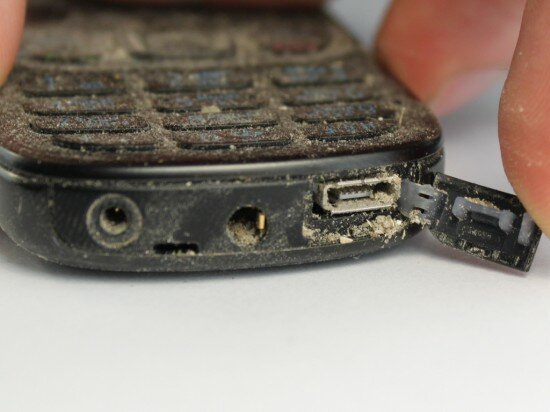
Pic. 8. Dust in the USB port
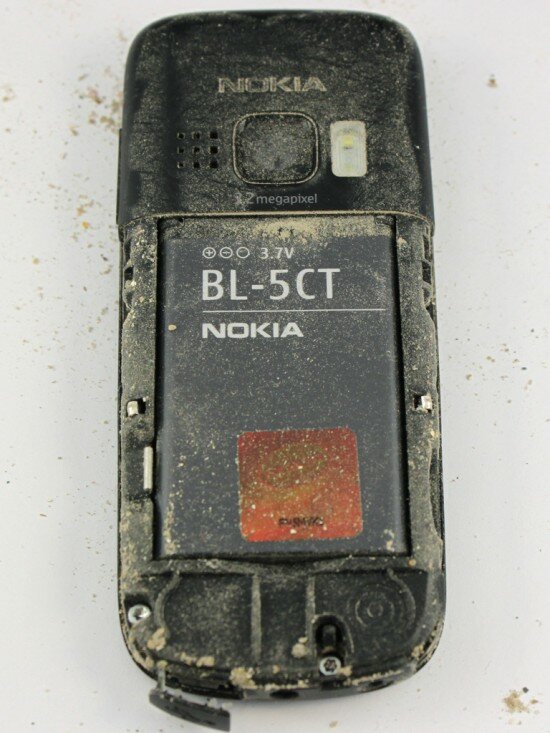
Pic. 9. Dirt under the battery cover
The grade is 12 (with 12 being the highest possible grade)
1.8 Connectivity
In order to test the reception quality of the Nokia 6303i classic, we placed it inside a box. Then we foiled the box (the foil served as a shield) and made a 40 x 50 mm (1.57 x 1.97 inches) hole in it.
Though the signal reception fell by 1-2 points (video 6) the Nokia 6303i classic received all incoming calls with no problem.
Video 6. Connectivity test
The grade is 15 (with 15 being the highest possible grade)
After the 1st stage of the stress test, the Nokia 6303i classic got 187 (with 192 being the highest possible grade)
2. Nokia 6303i classic stress test. Stage 2 — Tough conditions
2.1 Drop test
This time, we dropped the Nokia 6303i classic on the carpet from 1.5 m (4.9 ft) and from 50 cm (1.64 ft) on the tile (video 7, 8). The result was the same as in the previous drop test. The phone showed no damage and stayed functional.
Video 7. Drop on the carpet from 1.5 m (4.9 ft)
Video 8. Drop on the tile from 50 cm (1.64 ft)
The grade for the drop on the carpet is 30 (with 30 being the highest possible grade)
The grade for the drop on the tile is 30 (with 30 being the highest possible grade)
2.2 Squeeze test
We increased the applied pressure to 10 kg (22 lbs). The phone showed no damage, only the tone produced by the keyboard, but we can live with that.
The grade is 24 (with 24 being the highest possible grade)
2.3 Bend test
We increased the weight of the load to 5 kg (11 pounds). But the Nokia 6303i classic showed no sign of bend.
The grade is 24 (with 24 being the highest possible grade)
2.4 Durability
We increased this test to 10 minutes. This inflicted larger scratches on the plastic part of the back panel, compared to the result of the previous durability test (Pic. 10). But the metal casing showed even more damage. The paint on the edges was completely scuffed and we saw the steel casing under it (Pic. 11). A lot of minor scratches appeared on the battery cover.
Compared to the results showed by the metallic Nokia E71, the Nokia 6303i classic sustained more visible damage (let’s not to take into consideration, at least now, that these cell phone are of different class). The Nokia E71 got some scratches but the paint on the back stayed safe.
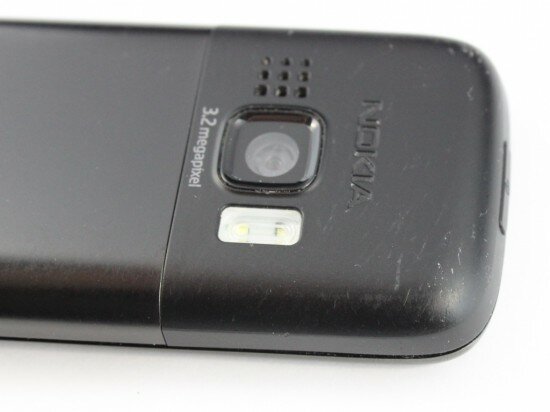
Pic. 10. Scratches on the plastic part of the back panel
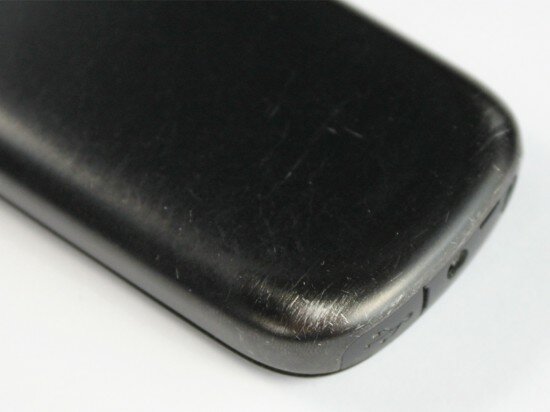
Pic. 11. Scuffs on the edges of the Nokia 6303i classic
The grade is 10 (with 15 being the highest possible grade)
2.5 Scratch test
We scratched the Nokia 6303i classic at the force of 300 g (0.66 lbs). The results showed that the protective lens glass is not very scratch resistant.
The test inflicted a visible scratch on the screen that ruined the quality of the picture (video 9). The back panel, however, showed no visible scratch.
Video 9. Screen scratching
The screen gets 10 points (with 15 being the highest possible grade)
The back cover gets 15 points (with 15 being the highest possible grade)
2.6 Freeze test
In order to check the performance of the Nokia 6303i classic in extremely cold weather, we took a box filled with ice cubes, placed the phone in it, and then placed the box in a freezer for 2 hours. The phone was left in speaking mode during that time.
After the test, we examined the phone. The capacity of the battery stayed full – the indicator displayed all bars. The display, however, malfunctioned (video 10). The keys, by the way, have quite a low stroke, but they became stiff after this test which made them uncomfortable to use.
Video 10. Freeze test
The grade is 12 (with 18 being the highest possible grade)
2.7 High temperature
In this stage of the test, we increased the time of heating to 5 minutes. The Nokia 6303i classic was so hot that nobody could take it by the hand. But the phone showed no sign of melting. The quality of the picture stayed fine.
The grade is 12 (with 12 being the highest possible grade)
2.8 Immersion in water
Water test is one of the most important and interesting parts of our review. In order to check water resistance of the phone, at first, we dunked it under water for 1 second (video 11).
This was too small period of time for water to penetrate the phone. The battery and the USB port stayed dry.
After the air drying the Nokia 6303i classic performed with no problem.
Video 11. Immersion in water for 1 second
The grade is 30 (with 30 being the highest possible grade)
2.9 Dust test
We increased the time of this test to 5 min. As a result, more dust accumulated under the back cover (Pic. 12).
We tested a lot of cell phones with steel battery covers and all of them were not dust resistant at all (e.g., the Nokia C5, the Nokia E71, the Nokia 6500 slide).

Pic. 12. The battery, covered with dust
The grade is 12 (with 12 being the highest possible grade)
2.10 Connectivity
We placed the Nokia 6303i classic in the box with the hole measured 20 x 20 mm (0,787 x 0,787 inches). This considerably reduced the signal. Though the indicator showed the same number of bars as in the previous test, the phone didn’t receive all incoming calls (video 12). Three times (with 10 being the maximum number of calls) we heard: “The subscriber is out of the coverage”.
Video 12. Connectivity test
The grade is 10 (with 15 being the highest possible grade)
After the 2nd stage of the stress test, the Nokia 6303i classic got 189 (with 240 being the highest possible grade)
3. Nokia 6303i classic stress test. Stage 3 — The toughest conditions
3.1 Drop test
In this stage of the test, we increased the height of the drops on the carpet (video 13) to 2 m (6.56 ft) and to 1 m (3.28 ft) on the tile (video 14).
In general, the Nokia 6303i classic showed good results. The battery cover opened and the battery fell out of the slot. But it happened only once, when the phone fell on the tile from 1 m (3.28 ft). The gadget showed no visible damage and stayed functional.
Video 13. Drop on the carpet from 2 m (6.56 ft)
Video 14. Drop on the tile from 1 m (3.28 ft)
The grade for the drop on the carpet is 30 (with 30 being the highest possible grade)
The grade for the drop on the tile is 30 (with 30 being the highest possible grade)
3.2 Squeeze test
This time, we increased the pressure we applied to 20 kg (44 lbs). The Nokia 6303i classic successfully passed this test. The steel well-rounded casing did its job perfectly.
The grade is 24 (with 24 being the highest possible grade)
3.3 Bend test
We applied 10 kg (22 lbs) weight in our 3rd attempt to bend the Nokia 6303i classic. The phone showed no sign of bend again which happens rarely in this part of the test (Pic. 13).
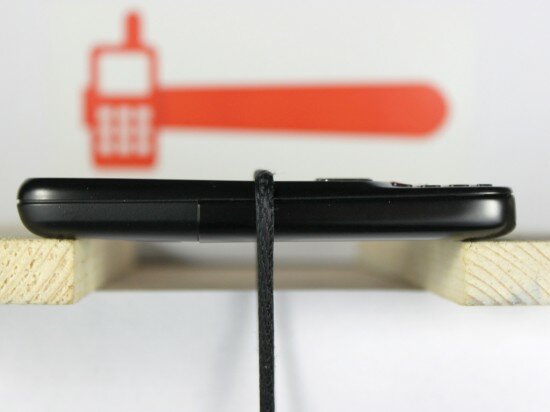
Pic. 13. The Nokia 6303i classic showed no sign of bend
The grade is 24 (with 24 being the highest possible grade)
3.4 Durability
In the last stage of this test, the drum was rotated for 20 minutes. The results we got were worse than in the previous tests. The large scuffs on the steel casing were visible from afar (Pic. 14). In some parts of the phone (e.g., on the edges near the keyboard), the steel became polished as if somebody had ground it with a file (Pic. 15).
The scuffs made the screen look albescent (Pic. 16). It completely ruined the quality of the picture. The keyboard, however, stayed as new. It showed no scratches at all. But the D-pad looked the same as the screen.
There is one more important thing. After this test the battery didn’t cling tightly to the sides of the slot and clattered inside the phone when we shook it. The Nokia 3720с showed the same result in this test.
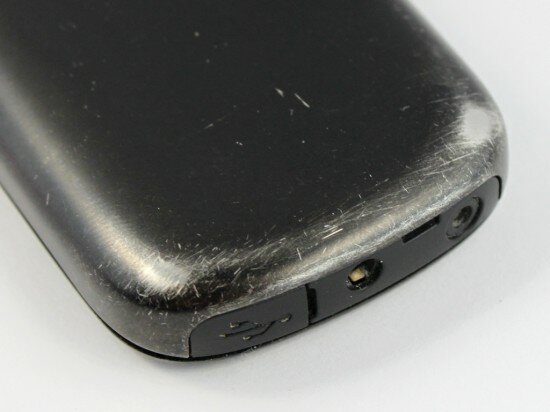
Pic. 14. Scuffs on the back panel

Pic. 15. Scratches on the front panel
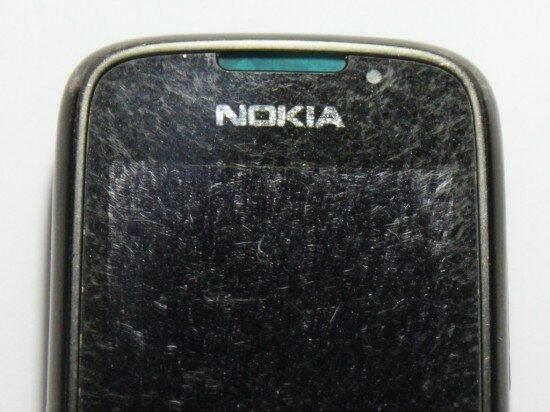
Pic. 16. Scuffs on the screen
The grade is 10 (with 15 being the highest possible grade)
3.5 Scratch test
In this test, we increased the force of scratches to 600 g (1.322 lbs). This inflicted a deep scratch on the screen (Pic. 17, video 15), but the back panel showed no sign of scratch at all (video 16).
Video 15. Screen scratching
Video 16. Back panel scratching
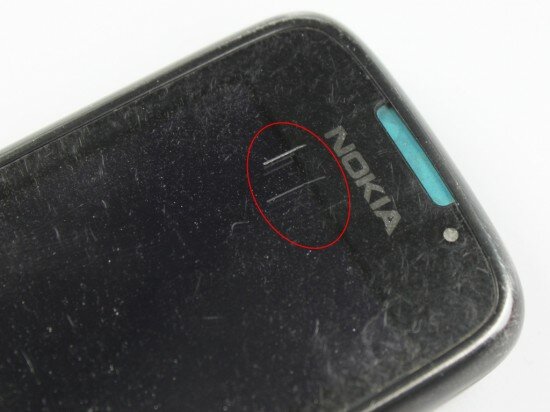
Pic. 17. Scratches on the screen
10 points for the screen (with 15 being the highest possible grade) for the screen
15 points for the back cover (with 15 being the highest possible grade) for the back cover
3.6 High temperature
We increased the time of this test to 10 minutes (video 17). The display of the Nokia 6303i classic became dim. But as the phone was cooling down, the display restored its original picture. The handset showed no sign of melting and stayed functional.
Video 18. High temperature test
The grade is 12 (with 12 being the highest possible grade)
3.7 Immersion in water
This time, we dunked the Nokia 6303i classic under water for 20 seconds (video 18). This period of time was more than enough for water to penetrate under the battery cover and even under the battery itself. Evidently, the circuit board got wet (Pic. 18). The USB port stayed dry, though (Pic. 19). The phone would have been broken if we hadn’t taken the battery out and dried the gadget for some hours. When we examined the Nokia 6303i classic once again it performed fine.
Video 18. Immersion in water for 20 seconds
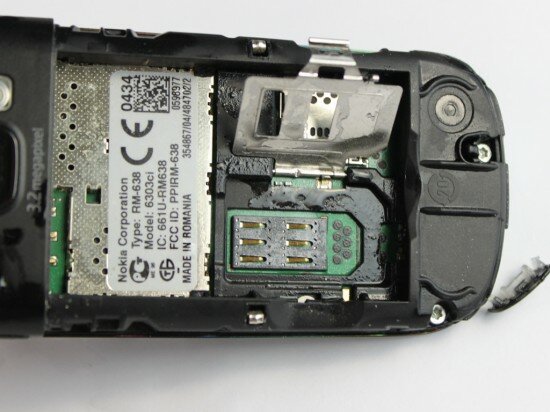
Pic. 18. Evidence of water inside the phone
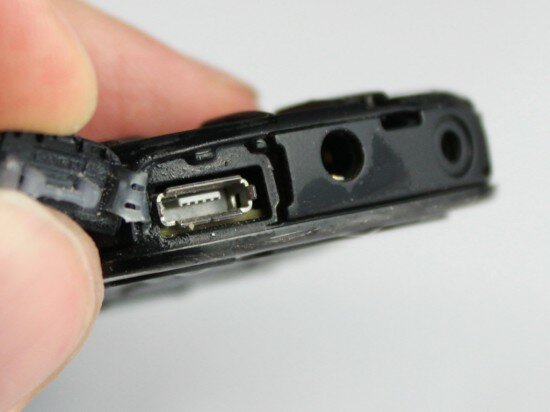
Pic. 19. The USB port stayed dry
The grade is 30 (with 30 being the highest possible grade)
3.8 Immersion in beer
We dunked the Nokia 6303i classic not only in water but also in beer. This immersion lasted for 10 seconds (video 19).
As a result, the beer penetrated the ear-microphone jack and the phone identified the headphones. We also saw the evidence of beer under the battery cover, but the circuit board stayed dry.
After the air drying we found out that the beer, however, penetrated the phone. A spot of beer appeared on the display and struck the eye when the color of the picture was light (Pic. 20). We also noticed that the Nokia 6303i classic didn’t vibrate when we set it to this mode. The phone restored this function after we slapped it for some times. Probably, some beer penetrated the vibration motor and glued together the parts of the trigger mechanism when the phone was drying out. Despite the spot of beer on the display, the gadget stayed absolutely functional.
Video 19. Immersion in beer for 10 seconds
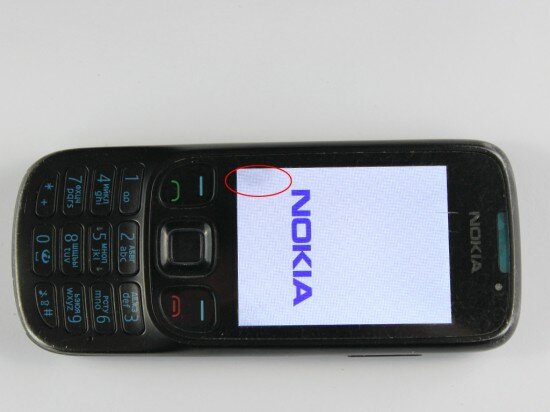
Pic. 20. Spot of beer on the display
The grade is 6 (with 9 being the highest possible grade)
3.9 Dust test
We increased the time of this test to 10 minutes. As a result, a lot of dust filled the gaps between the keys and made the keys very stiff. Some of them, simply, didn’t work (Pic. 21).
We had to disassemble the Nokia 6303i classic in order to get rid of the dust and make the keys functional again. So we lowered the grade for the phone in this test. We also saw a lot of dirt under the battery cover (Pic. 22). This is a record amount of dirt that we experienced to see in the result of this test. In this stage of the experiment, a few grains of dust penetrated even under the screen (Pic. 23).
When we examined the Nokia 6303i classic more carefully we found out that the vibration motor stopped working again. In order to find the reason, we had to disassemble the phone.
Catching the ball before the bound, we didn’t only have to clean the gadget. We had to do a lot more because dust penetrated the vibration motor and damaged the trigger mechanism.
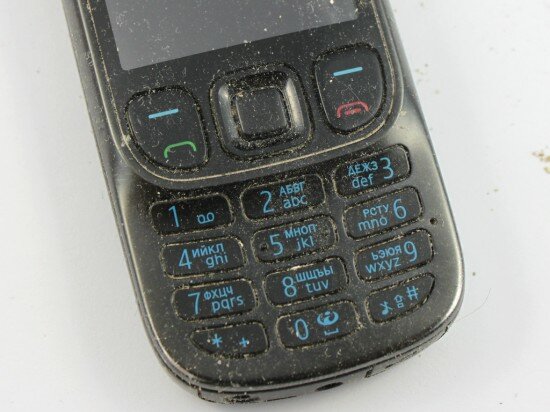
Pic. 21. Dust in the gaps between the keys
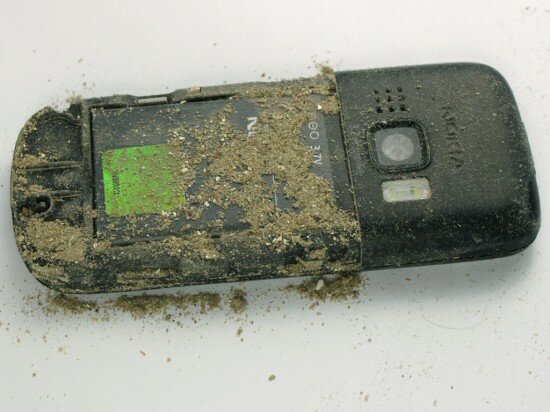
Pic. 22. We saw this when we released the battery cover
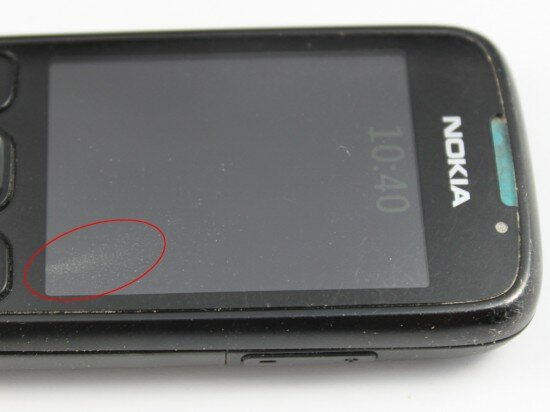
Pic. 23. Dust under the protective lens glass
The grade is 5 (with 12 being the highest possible grade)
3.10 The keyboard
Despite the keys of the numeric pad have a low stroke, they are comfortable to use. The keyboard is made of a durable material and stayed attractive after all the stress tests. The D-pad, however, is made of a glassy plastic. It didn’t look fine after the shock tests.
The performance of the Nokia 6303i classic in cold weather leaves much to be desired and we advice you to keep this phone in the inset pocket rather than in a bag if you are out on a frosty winter day.
Try not to use this handset in a dusty environment because this can damage the keyboard. We lowered the grade for the keyboard in this part of the review because some keys stopped working after the dust test.
The grade is 5 (with 15 being the highest possible grade)
3.11 Connectivity
In the last stage of this experiment, we placed the Nokia 6303i classic in the box with the hole measured 15 x 15 mm (0,59 x 0,59 inches). The results were pretty much the same as in the previous connectivity test (video 20). Three times the phone was in the dead zone and once the call got dropped. The other 6 calls were successfully received by the Nokia 6303i.
Video 20. Connectivity test
The grade is 10 (with 15 being the highest possible grade)
3.12 Short circuit and overcharge
We started with the light shocks. We took a forceps and made a 1 second short circuit of the battery charger’s power supply terminals (video 21). As a result, the battery charger stayed absolutely functional.
Video 21. Short circuit of the battery charger
We did the same with the battery itself: short circuit of the battery for 1 second (video 22). The battery stayed safe and full.
Video 22. Short circuit of the battery
Next, we checked the reaction of the Nokia 6303i classic to the increase and decrease in charging voltage. We plugged the battery charger in the PSU and the PSU, in its turn, was plugged in the phone (video 23). At first, we increased the power of charging to 8 V. The power consumption also increased, but the Nokia 6303i classic kept charging. However, we can’t say that 600 mA is too much power and it’s not dangerous for the phone.
The reaction of the handset to decrease in charging voltage was much better. The phone stopped charging when the power was decreased to 3.3 V.
Video 23. Increase in charging voltage
Finally, we examined the phone’s energy consumption. We took the battery out and plugged the PSU in the phone (video 24). At first, we increased the energy supply to 7 V. The Nokia 6303i classic survived with no problem. The power consumption stayed normal.
We also decreased energy supply until the gadget switched off. It happened at 3 V. The phone gave a warning that the battery was empty, beeped and switched itself off.
Video 24. Increase in energy supply
For the ability to withstand short circuits the battery charger gets 15 points (with 15 being the highest possible grade)
For the ability to withstand short circuits the battery gets 15 points (with 15 being the highest possible grade)
For the ability to withstand an increase/decrease in charging voltage the Nokia 6303i classic gets 15 points (with 15 being the highest possible grade)
For the ability to withstand an increase/decrease in energy supply the Nokia 6303i classic gets 15 points (with 15 being the highest possible grade)
3.13 Disassembling
After the stress tests we disassembled the Nokia 6303i classic. The build quality is the same as in all the Nokia cell phones. The antenna is built in the handset just above the camera lens. This is the only part of the gadget that is made of plastic.
Most of the elements of the circuit board have a graphite coating (Pic. 25) which prevents them from being oxidized. The microchip that is responsible for RAM is fixed above the processor. This type of assembly is widely used not only by the Nokia but also by its competitors. The circuit board of the Nokia 6303i classic is not compounded, by the way.
At last, we tried to replace the vibration motor. We had to use the soldering iron because the vibration motor is fixed to the circuit board (near the flash connector).
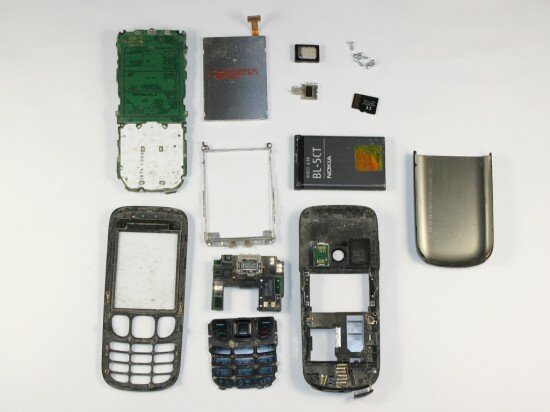
Pic. 24. The Nokia 6303i classic disassembled
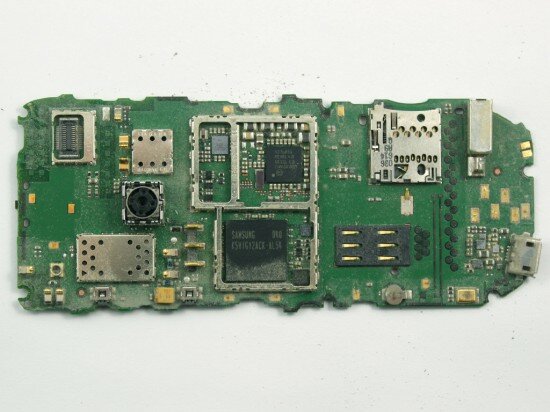
Pic. 25. The circuit board of the Nokia 6303i classic
The grade is 15 (with 15 being the highest possible grade)
After the 3rd stage of the stress test, the Nokia 6303i classic got 275 points (with 351 being the highest possible grade)
Conclusion:
The Finnish manufacturer produced a handy cell phone with fine build quality and attractive design. The Nokia 6303i classic is tough enough to withstand quite accidental drops and survives exposure to heat. However, it has problems with dust and water resistance. Water and beer penetrated the phone during the stress tests. If you happen to drop this phone in water or beer take the battery out and dry the handset immediately. Otherwise, it can be broken.
At first glance, the keyboard is rugged but it showed poor results in the dust tests. This is the first time when the keys were completely damaged by dirt. Moreover, the keyboard becomes stiffer in cold weather and the display malfunctions. By the way, if you clasp the cold steel casing to your cheek, you’ll get a lot of stress. The capacity of the battery doesn’t go down rapidly, though.
If you think that the metallic body makes the Nokia 6303i classic ruggedized you are a little bit mistaken. We advice you pay attention to the new models of robust cell phones (e.g., the Nokia 3720c). But if you are inspired by the refined design of the Nokia 6303i classic, you won’t be disappointed. Remember that the paint on the steel casing is not durable at all and after a year or two (it depends on how careful you are), your Nokia 6303i classic will look the same as our Nokia 6303i classic after the durability tests.
Here’s how the phone looks like after all the tests (Pic. 25, 26, video 25).
Video 25. Here’s how the gadget looks like after all the stress tests
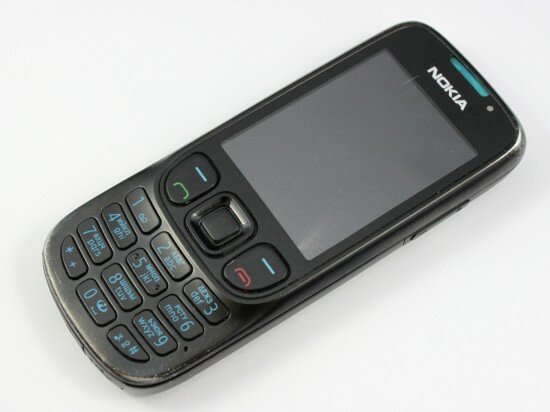
Pic. 26. The front panel of the phone after the test
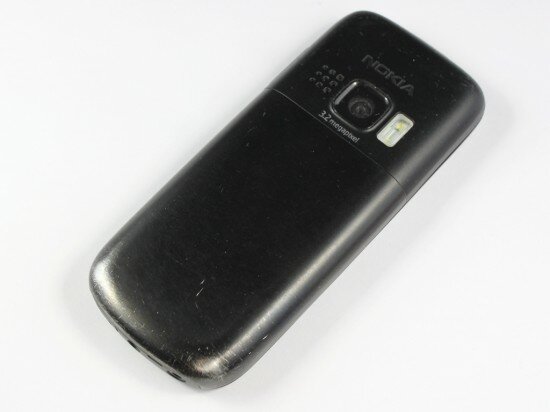
Pic. 27. The back panel of the phone after the test

 Russian version
Russian version
Comment (1)
am a Nokia phone fan for a long time now. I like the features in them and ease to use. when I lost my Nokia last year-2010, i went for a cheap one Nokia N1200. it works for me.
But the Nokia 6303i Classic is definitely a must get
thanks for the test. am more confident now about Nokia 6303i Classic